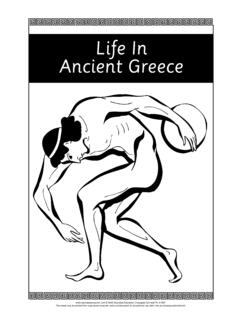Transcription of Archaic Greek Art (700 480 BC) - Saylor Academy
1 # The Saylor Foundation Page 1 of 6 Archaic Greek Art (700 480 BC) The seventh century BC saw the beginning of the Archaic period of Greek art. Influenced by their Eastern neighbors, such as the Egyptians and the peoples of Anatolia ( , the Hittites and Lydians), the Greeks adopted new styles that soon replaced the spare, abstract geometric patterning that had been common since the fall of Mycenaean civilization. Greek colonization in Asia Minor on the Ionian Coast, as well as trading settlements established in places such as Egypt, brought Greeks into contact with these Eastern civilizations. The Greeks in the East brought styles and ideas back with them to mainland Greece, leading to a cultural synthesis and the formation of new and innovative styles. Combining these new themes and styles with their own tastes and techniques, the Greeks produced their own unique art. The Archaic period thus presents the beginning of the artistic forms that would characterize ancient Greek culture and civilization.
2 Vase Painting Pottery was an important commodity in the ancient Greek world. Not only was it functional, but it also offered opportunities for artists to display their abilities. Finely painted pots were a valuable luxury item. Pots were produced in pieces. The main bowl section was produced with clay on a wheel. Then a neck and a base (called a foot) would be formed of clay and attached. The potter would fill in the joints with a slip, a more liquid form of clay, to seal them. Finally, handles could be attached to the pot. Then the pot would be fired in a kiln, which made the clay hard and durable. The Archaic period saw the gradual transformation of the Geometric style of vase painting, characterized by linear bands decorated with geometric shapes. Gradually, late Geometric vases included abstract animals or people between the bands. With the influence of Eastern styles, so-called Orientalizing art appeared, which included mythological animals such as griffins (part bird, part lion), sphinxes (part woman, part winged lion), and sirens (part woman, part bird).
3 Palm leaves and lotuses became common decoration. Greek artists also readily adopted themes from Eastern art, such as animal hunts. In the polis of Corinth, where vase painting arose early as a local specialty, a popular style depicted tapestry-like patterns of silhouetted animals real and mythological embellished by plant or rosette decoration. Around 700 BC, the Corinthians discovered a new technique, black-figure vase painting. Black-figure pottery was produced by painting images with a glossy clay slip onto unfired pottery. Corinthian potters Corinthian vase. Notice the various real and mythological animals divided into different registers. Terms of Use: The image above is in the public domain and is attributed to Wikipedia user Marie-Lan Nguyen. The original can be found here. # The Saylor Foundation Page 2 of 6 had discovered that a certain type of slip could turn black when the pot was being fired. They would first fire the vase in normal conditions, then increase the temperature and remove the oxygen from the kiln, which would turn the pottery black.
4 Finally, oxygen would be reintroduced to the kiln, returning the pottery to an orange color, but the area covered in the slip would remain black. This allowed scenes to be baked onto the pottery. Black-figure vase painting revolutionized the production of pottery, and allowed for experimentation with new artistic techniques. Some of the earliest artists known by name were painters of such pottery who became renowned for their skills. The disadvantage of black-figure technique is that the black figures looked like little more than silhouettes. In order to add surface detail onto them, artists would scrape the clay before firing to produce lines, thus creating details such as facial features, armor, and so on. Artists also added red and white paint after baking to produce such details and give the vases more color. Corinth, where artists produced vases that generally depicted scenes of animals, was the leading exporter of black-figure vases early on. But gradually Athens mastered the style and superseded Corinth in the manufacture of black-figure vases.
5 Athenian vases became a major commodity in the Mediterranean world. Mythological scenes, especially scenes from the Odyssey and the Iliad, were common, as were scenes of Greek daily life . Athenian vase paintings, in particular, preserve informative scenes of exercise, warfare, dining, religious customs, funeral rites, and many other aspects of life in a Greek polis. The clay around Athens was iron-rich and ideally suited for the vibrant, orange color of vases. Athens produced a number of great artists who created distinctive styles. Around 530 BC, red-figure painting, a new technique for vase painting, was introduced in Athens. Its invention is attributed to the artist Andokides. While black-figure vases continued to be produced, red-figure vases became the most common form of Greek vase painting and were extremely popular. Over 40,000 examples survive from Athens alone. Red-figure painting was the inverse of black-figure painting: The slip was painted as a background, with the figures left as a negative.
6 Once the vessel was fired, the whole pot would turn black except for the figures, which turned red. The advantage of red-figure painting was that black details could be added to the red figures Early Athenian black-figure vase. Notice the black figures incised with details from before the firing of the clay, and then embellished with further details in red and white paint. Terms of Use: The image above is in the public domain and is attributed to Wikipedia user Bibi Saint-Pol. The original can be found here. # The Saylor Foundation Page 3 of 6 with the slip that is, instead of incising the details, they could be painted on. Since a brush was better suited to adding these details, it allowed for more refined and lifelike images. Red-figure vase painting was invented in Athens, which remained the center of red-figure pottery, and no other polis could compete with its production. Although some potteries were produced as masterworks of artistic style, others were produced quickly for mass consumption.
7 The Greek colonies of southern Italy were another major place for the production of red-figure vases, and such Greek pottery was highly prized among their Etruscan neighbors to the north. Red-figure pottery continued to be produced after the Archaic period in Greece. It remained the primary style of vase painting until the late third century BC, when a return to simpler forms and abstract images prevailed. Thus, red-figure vase painting is considered the apex of Greek pottery production and is the source of some of the finest examples of vase painting in the Mediterranean world. Sculpture Greek sculpture began in the Archaic period. Early Greek sculpture was inspired by stone sculptures from the East, especially Egypt. Greek sculptures in this period were often life -sized or larger, and almost always depicted either a nude young man (kouros), or a clothed young woman (kor ). (Since male nudity was considered appropriate, but female nudity was not permitted in public, the statues reflect these values.)
8 While these statues are distinguished by the stiff, angular posture of their subjects (a legacy of the Egyptian influence), with the left foot advancing forward, the Greeks developed a characteristic Archaic smile to make them more lifelike. Their hair is usual braided and ropelike, with little resemblance to real hair. A detail from a red-figure vase of the Archaic period. Notice the high level of detail made possible by this style. Terms of Use: The image above is in the public domain and is attributed to Wikipedia user Bibi Saint-Pol. The original can be found here. Kouros from around 600 BC. Notice the stiff form and clear influence from Eastern civilizations. Terms of Use: The image above is in the public domain and is attributed to Wikipedia user Bibi Saint-Pol. The original can be found here. # The Saylor Foundation Page 4 of 6 The earliest surviving examples of Greek sculpture date from the seventh century BC and come from a religious sanctuary on the island of Delos. Greek sculptures were initially produced for religious use.
9 They were either erected in sanctuaries of the gods, or used as burial markers and memorials. Wealthy aristocrats probably commissioned many of the surviving sculptures. Since the Greeks believed that their gods had human form, there was no distinction between divine and human bodies. Archaic sculptures could be representations of gods, humans, or both. The male statues, kouroi, seem to have originated at temples and sanctuaries of Apollo, suggesting that the style originally developed out of religious worship. Over the course of the Archaic period, Greek sculpture became more realistic and naturalistic. Greek artists achieved a better understanding of the human form. By the beginning of the fifth century BC, they adopted what is called the Severe style. The Archaic smile disappears and statues are differentiated as either humans or gods. This paved the way for the development of Greek classical sculpture, which would come to look naturalistic and display greater artistic skill and variation.
10 Architecture The Archaic period saw the construction of Greek temples. Greek religious worship did not take place inside the temples; temples were designed, rather, to house the cult image of a god and the votive offerings to the god. The basic plan of Greek temples seems to have been developed from that of the megarons, the great halls of early Greek rulers. The first Greek temples were made of wood, but by the Archaic period builders began to use stone. Still, the stone temples mimicked their wooden predecessors. For example, wooden tree-trunk supports were replaced by marble columns. The Doric order of temples developed Athenian kor from around 530 BC. Notice the Archaic smile. Terms of Use: The image above is licensed under a Creative Commons Attribution-Share Alike Generic license, and is attributed to Wikipedia user Marsyas. The original can be found here. Kouros from circa 530 BC. Notice the significant developments in naturalism since the beginning of the century. Terms of Use: The image above is in the public domain and is attributed to Wikipedia user Mountain.

















